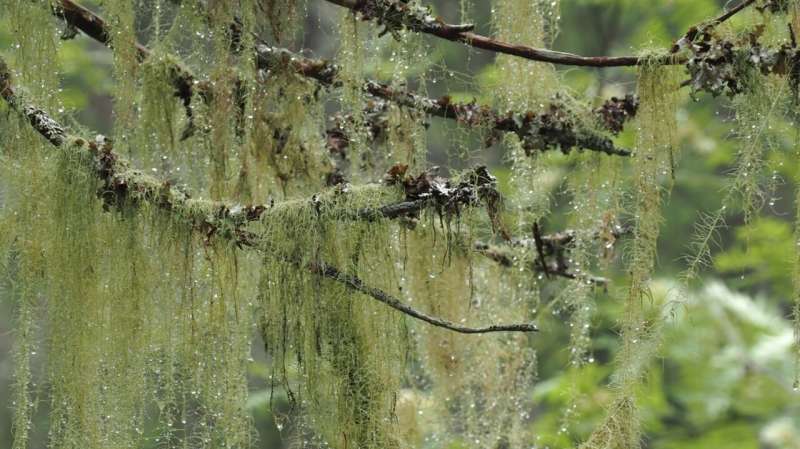This article has been reviewed according to Science X's editorial process and policies. Editors have highlighted the following attributes while ensuring the content's credibility:
fact-checked
peer-reviewed publication
trusted source
proofread
World's longest lichen declines in a national park

A unique long-term study performed by researchers at Umeå University shows that the pendent lichen Usnea longissima has decreased by 42% over 37 years in Skuleskogen National Park, located in High Coast UNESCO World Heritage site. The study has been published in the journal Forest Ecology and Management.
"It is well known that that pendent lichens decrease in managed forests. This study suggests that the long-term survival of red-listed lichens may be threatened also in forests that have a strong protection," says Per-Anders Esseen, professor emeritus at Department of Ecology and Environmental Science, Umeå University.
Usnea longissima (Methuselah's beard lichen) was probably the original "tinsel" placed on Christmas trees and may reach a length of several meters. It grows in old and humid spruce forests and is an important indicator of biodiversity in forests. It is red-listed as vulnerable and protected by law in Sweden. Sweden and Norway host the largest occurrences in Europe and therefore have particular responsibility to protect the lichen.
"Long-term data on spatial dynamics of populations of red-listed species are fundamental for understanding and predicting how these species respond to global change drivers. Such knowledge is also needed to develop effective conservation measures," says Per-Anders Esseen.
Detailed inventory
The researchers performed a detailed inventory of U. longissima in Skuleskogen in 1984. A total of 355 trees hosting the lichen were tagged with an aluminum plate buried in the ground. The inventory was repeated in 2021 and a metal detector was used to search for the plates. The researchers found that the lichen was extinct on 81% of the tagged trees.
The extinction was higher on trees that were still standing (stochastic extinction) than extinction caused by treefalls (deterministic extinction). A total of 207 newly colonized trees were also detected, reflecting substantial turnover of host trees within local populations.
The study also provides key findings about the spatial dynamics of U. longissima in forest landscapes and shows that the lichen is strongly dispersal-limited. The lichen mainly disperses with larger fragments, which only dispersed a few meters over 37 years. The poor dispersal explains the lichen's strong dependence on long continuity of forest cover and preference for sites not subjected to fire. This also explains why the distribution of the lichen in the National Park was stable over the study period.
Lichens are complex partnerships between fungi, photobionts (an alga, or a cyanobacterium) and other bacteria. They lack roots and passively take up water. Thin pendulous lichens, for example, Usnea longissima, are particularly sensitive to environmental hazards such as air pollution, forestry, and climate change, yet are vital components of forest canopies worldwide. Pendent lichens contribute to nutrient cycling in forests and provide habitat for insects and spiders. They also constitute important fodder for reindeer during winter when ground-lichens are inaccessible.
Pollution and climate change
Data on composition and age of the forests indicate extensive harvesting between 1860 and 1900 in Skuleskogen, but the researchers found no evidence of large-scale disturbances during the last 80 years. Instead, the decline of U. longissima was probably driven by a combination of air pollution (mainly deposition of nitrogen), climate change with milder and more snow-rich winters and heat waves in summers, as well as denser forests. The lichen is also threatened by storms and fires, says Esseen.
The study highlights the necessity of developing a comprehensive action plan for securing the long-term survival of this unique lichen in Sweden, says Esseen. It is also important to start a national program for monitoring of red-listed lichens in both protected and managed forests.
More information: P.-A. Esseen et al, Long-term dynamics of the iconic old-forest lichen Usnea longissima in a protected landscape, Forest Ecology and Management (2023). DOI: 10.1016/j.foreco.2023.121369
Journal information: Forest Ecology and Management
Provided by Umea University




















